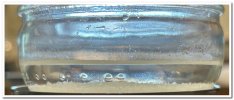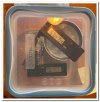JCinPA
Well-Known Member
- Joined
- Mar 24, 2025
- Messages
- 145
- First Name
- John
After watching an old Xikar YouTube video where their engineer suggested this:

I began to wonder where the "wet sand consistency, no visible water" advice started. For that matter, why do so many Internet sources recommend a "2L bottle cap" or "Ziplock bags"? Sure sounds like people are just repeating what they have heard. Verbatim. So in my usual OCD fashion, I started overthinking this, and researching science papers. I found several papers which all talked about a "saturated solution". One actually gave a recipe.

 www.reference.com
www.reference.com
It was 357 grams of salt, to 1 liter of water. Doing a little quick calculator work I found that would equate to 21 grams of salt in 2 oz of distilled water, so using a kitchen scale and cocktail measure, I measured it out, stirred till all the salt dissolved, and added a pinch more so there was visible salt in the bottom of my glass container--it looked like almost all liquid. I then sealed this with a recently-calibrated hygrometer (using a Boveda kit) in a smallish food container with a snap lid and gasket. Baggies are no bueno. After 24 hours at 68F it read 75%.
Then I did what Xikar recommended, add salt to distilled water and stir, stir, stir, until I could get no more salt to dissolve, and had water covering the salt. After 24 hours at 68F, it read 75%. My salt solution looked like this.

From the side so you can gauge how much liquid is in there.

Then I did the "wet sand" approach. I used 1 Tblsp salt and 1 Tsp of water. After 24 hours at 68F, you guessed it--75%. Here are three Caliber IV units in the container so you can see how big the container is and how much salt I used. All three are reading 75%.

I was perplexed because I had heard how careful you need to be and how results can vary a lot if you're not careful. So, in true OCD fashion. I did the tests again. All three. But using only one hygrometer this time (I used the other two with cigars). Mostly water with a very little salt. Plenty of salt but covered with a little water after serious stirring to ensure I had dissolved all the salt it would take. And the 1 Tblsp salt to 1 tsp water again very sandy. All read 75% the second time around. Just for good measure, I put the Caliber IV back in the Boveda calibration bag again. Still 75%.
The science papers I read all said that the solution is key, and like a mixture of water and ice cubes will stay at 32F as long as liquid and solid water are both present, apparently if you have both liquid water and solid salt present, the vapor pressure above the solution in a sealed container will stay at 75% RH. Well, 75.4% at 68F to be precise (varies with temperature).
What did I glean from this massive waste of time?
1. If done properly and carefully, this method is reliable, accurate, and repeatable. And practically fool-proof. How to do it properly and carefully?
2. Stop using plastic bags, as @BlindedByScience has repeatedly admonished us. Don't even use cheap, disposable GladWare type containers. Get a mason jar or a snap-lid plastic container with a gasket you would consider using for a tupperdore. Keep it fairly small.
3. Stop using the bottle cap. That is clearly people quoting stuff they've read on the Internet. Use a bunch of salt, it's cheap! I probably have several tablespoons dissolved in that little bowl above. If you use a larger volume than a bottle cap, you'll see the results quicker and the larger volume of solution should be more stable in your closed container.
4. Be patient. You'll see it settle sooner, but give it 24 hours.
Apparently the damp sand will work, which surprised me because I thought that would introduce variation, but it worked just as well as the watery solutions. But I'd stop worrying about the "damp sand" warnings and add water until you do have a wet slurry. It should be most accurate if there is both visible liquid water and solid salt present, and if you've stirred it enough, the RH% should be the same.
Boveda kit, three solutions, three solutions again, and Boveda kit, all read 75%. This is a robust method. If you've had problems with it, it's likely due to using baggies or not having a good seal on your container. If you use salt in a good container, properly stirred so you know it won't take any more salt, and you don't get 75%, your hygro is bad. I was amazed at how repeatable this is. Stop worrying about the "wet sand" warnings, it simply does not matter.

I began to wonder where the "wet sand consistency, no visible water" advice started. For that matter, why do so many Internet sources recommend a "2L bottle cap" or "Ziplock bags"? Sure sounds like people are just repeating what they have heard. Verbatim. So in my usual OCD fashion, I started overthinking this, and researching science papers. I found several papers which all talked about a "saturated solution". One actually gave a recipe.

How Do I Make a Saturated Sodium Chloride Solution?
To make a saturated solution of sodium chloride, find the solubility of sodium chloride in water, mix a solution of sodium chloride and water, and watch for saturation. The solubility of sodium chloride is 357 grams per 1 liter of cold water. The solubility of sodium chloride will change based...
It was 357 grams of salt, to 1 liter of water. Doing a little quick calculator work I found that would equate to 21 grams of salt in 2 oz of distilled water, so using a kitchen scale and cocktail measure, I measured it out, stirred till all the salt dissolved, and added a pinch more so there was visible salt in the bottom of my glass container--it looked like almost all liquid. I then sealed this with a recently-calibrated hygrometer (using a Boveda kit) in a smallish food container with a snap lid and gasket. Baggies are no bueno. After 24 hours at 68F it read 75%.
Then I did what Xikar recommended, add salt to distilled water and stir, stir, stir, until I could get no more salt to dissolve, and had water covering the salt. After 24 hours at 68F, it read 75%. My salt solution looked like this.

From the side so you can gauge how much liquid is in there.

Then I did the "wet sand" approach. I used 1 Tblsp salt and 1 Tsp of water. After 24 hours at 68F, you guessed it--75%. Here are three Caliber IV units in the container so you can see how big the container is and how much salt I used. All three are reading 75%.

I was perplexed because I had heard how careful you need to be and how results can vary a lot if you're not careful. So, in true OCD fashion. I did the tests again. All three. But using only one hygrometer this time (I used the other two with cigars). Mostly water with a very little salt. Plenty of salt but covered with a little water after serious stirring to ensure I had dissolved all the salt it would take. And the 1 Tblsp salt to 1 tsp water again very sandy. All read 75% the second time around. Just for good measure, I put the Caliber IV back in the Boveda calibration bag again. Still 75%.
The science papers I read all said that the solution is key, and like a mixture of water and ice cubes will stay at 32F as long as liquid and solid water are both present, apparently if you have both liquid water and solid salt present, the vapor pressure above the solution in a sealed container will stay at 75% RH. Well, 75.4% at 68F to be precise (varies with temperature).
What did I glean from this massive waste of time?
1. If done properly and carefully, this method is reliable, accurate, and repeatable. And practically fool-proof. How to do it properly and carefully?
2. Stop using plastic bags, as @BlindedByScience has repeatedly admonished us. Don't even use cheap, disposable GladWare type containers. Get a mason jar or a snap-lid plastic container with a gasket you would consider using for a tupperdore. Keep it fairly small.
3. Stop using the bottle cap. That is clearly people quoting stuff they've read on the Internet. Use a bunch of salt, it's cheap! I probably have several tablespoons dissolved in that little bowl above. If you use a larger volume than a bottle cap, you'll see the results quicker and the larger volume of solution should be more stable in your closed container.
4. Be patient. You'll see it settle sooner, but give it 24 hours.
Apparently the damp sand will work, which surprised me because I thought that would introduce variation, but it worked just as well as the watery solutions. But I'd stop worrying about the "damp sand" warnings and add water until you do have a wet slurry. It should be most accurate if there is both visible liquid water and solid salt present, and if you've stirred it enough, the RH% should be the same.
Boveda kit, three solutions, three solutions again, and Boveda kit, all read 75%. This is a robust method. If you've had problems with it, it's likely due to using baggies or not having a good seal on your container. If you use salt in a good container, properly stirred so you know it won't take any more salt, and you don't get 75%, your hygro is bad. I was amazed at how repeatable this is. Stop worrying about the "wet sand" warnings, it simply does not matter.
Last edited:

